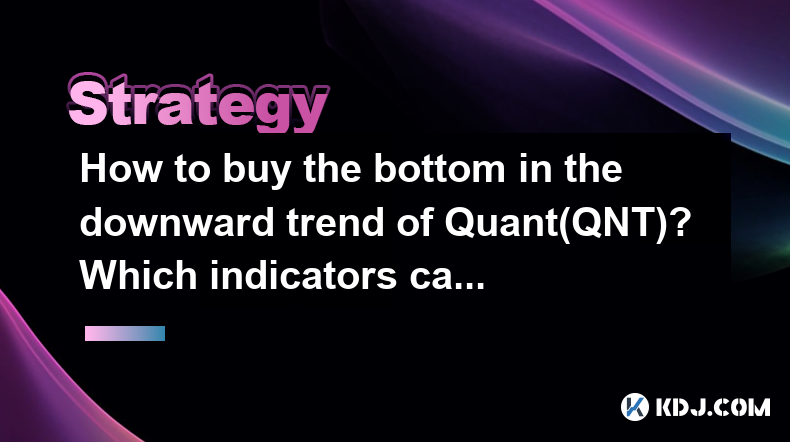-
 bitcoin
bitcoin $108842.957301 USD
-1.88% -
 ethereum
ethereum $3931.777121 USD
-1.66% -
 tether
tether $1.000186 USD
-0.03% -
 bnb
bnb $1153.250882 USD
-2.20% -
 xrp
xrp $2.367904 USD
-1.94% -
 solana
solana $186.182050 USD
-4.20% -
 usd-coin
usd-coin $0.999997 USD
0.00% -
 tron
tron $0.316949 USD
-1.00% -
 dogecoin
dogecoin $0.190780 USD
-3.12% -
 cardano
cardano $0.651324 USD
-2.67% -
 hyperliquid
hyperliquid $37.141055 USD
-0.85% -
 ethena-usde
ethena-usde $0.999224 USD
-0.09% -
 chainlink
chainlink $17.579031 USD
-2.47% -
 bitcoin-cash
bitcoin-cash $509.426284 USD
-2.79% -
 stellar
stellar $0.315298 USD
-2.93%
How to buy the bottom in the downward trend of Quant(QNT)? Which indicators can assist in judgment?
Use RSI, MACD, Bollinger Bands, and volume to identify the bottom in Quant (QNT)'s downward trend, but always manage risks with stop-loss orders and diversification.
May 01, 2025 at 08:14 am

Buying the bottom during a downward trend in any cryptocurrency, such as Quant (QNT), can be a lucrative strategy but also fraught with risks. This article will guide you through the process of identifying the bottom in a downward trend for QNT and highlight several technical indicators that can assist in making informed decisions.
Understanding the Downward Trend of Quant (QNT)
A downward trend in Quant (QNT) indicates that the price of the cryptocurrency is consistently moving lower over time. This trend can be identified by a series of lower highs and lower lows on the price chart. Recognizing this trend is the first step in attempting to buy at the bottom, as it helps you understand the overall market sentiment and direction.
Key to identifying a downward trend is to observe the price action over a period, typically using a longer timeframe such as daily or weekly charts. This will give you a clearer picture of the trend's strength and duration.
Importance of Buying the Bottom
Buying the bottom during a downward trend means purchasing Quant (QNT) when the price has reached its lowest point before it starts to recover. This strategy can potentially lead to significant profits if the price rebounds strongly. However, timing the bottom correctly is challenging and requires a combination of technical analysis and market understanding.
The main advantage of buying the bottom is the potential for high returns as the price increases from its lowest point. However, the risk is that the price could continue to fall, leading to losses.
Technical Indicators for Identifying the Bottom
Several technical indicators can assist in identifying the bottom of a downward trend in Quant (QNT). Here are some of the most effective ones:
1. Relative Strength Index (RSI)
The Relative Strength Index (RSI) is a momentum oscillator that measures the speed and change of price movements. It ranges from 0 to 100 and is typically used to identify overbought or oversold conditions.
- An RSI value below 30 indicates that Quant (QNT) might be oversold, suggesting a potential bottom.
- Conversely, an RSI value above 70 indicates overbought conditions, which might signal a reversal if it starts to decline.
To use RSI for identifying the bottom:
- Monitor the RSI on a daily chart to see if it falls below 30.
- Look for divergence where the price continues to make new lows, but the RSI starts to rise, indicating weakening downward momentum.
2. Moving Average Convergence Divergence (MACD)
The Moving Average Convergence Divergence (MACD) is a trend-following momentum indicator that shows the relationship between two moving averages of a security’s price.
- The MACD line is calculated by subtracting the 26-period Exponential Moving Average (EMA) from the 12-period EMA.
- The signal line is a 9-period EMA of the MACD line.
- A bullish crossover occurs when the MACD line crosses above the signal line, which can indicate a potential bottom.
To use MACD for identifying the bottom:
- Watch for the MACD line to cross above the signal line after a period of downward movement.
- Confirm with the histogram, which should start to move from negative to positive values.
3. Bollinger Bands
Bollinger Bands consist of a middle band being a simple moving average (SMA) and two outer bands that are standard deviations away from the middle band.
- When the price of Quant (QNT) touches or moves outside the lower Bollinger Band, it may indicate that the price is oversold and potentially at the bottom.
- A subsequent move back inside the bands can signal a potential reversal.
To use Bollinger Bands for identifying the bottom:
- Observe when the price touches or falls below the lower Bollinger Band.
- Look for the price to start moving back inside the bands, which could indicate a potential bottom.
4. Volume
Volume is a crucial indicator that can help confirm the bottom in a downward trend. High volume during a price decline can indicate strong selling pressure, but a subsequent increase in volume during a price rise can signal a potential bottom.
To use volume for identifying the bottom:
- Monitor the volume during the downward trend to see if it spikes at the bottom.
- Look for an increase in volume as the price starts to rise, which can confirm a potential bottom.
Practical Steps to Buy the Bottom in Quant (QNT)
Here are the practical steps you can follow to buy the bottom in Quant (QNT) during a downward trend:
- Choose a reliable exchange: Select a cryptocurrency exchange that supports Quant (QNT) and has a good reputation for security and liquidity.
- Set up your trading account: Complete the necessary verification processes and deposit funds into your account.
- Use technical analysis tools: Apply the indicators mentioned above (RSI, MACD, Bollinger Bands, and volume) to your trading platform.
- Identify the potential bottom: Use the indicators to find signs of a potential bottom in the downward trend.
- Place your order: Once you have identified a potential bottom, place a buy order for Quant (QNT) at the desired price level.
- Monitor your position: Keep an eye on the price movement and be prepared to adjust your strategy if the market conditions change.
Risk Management When Buying the Bottom
Buying the bottom in a downward trend carries significant risks, and it's essential to implement proper risk management strategies:
- Set stop-loss orders: Place a stop-loss order to limit potential losses if the price continues to fall after your purchase.
- Diversify your portfolio: Don't put all your funds into one cryptocurrency; spread your investments across different assets to reduce risk.
- Use position sizing: Only invest a small portion of your total capital in any single trade to manage risk effectively.
- Stay informed: Keep up with market news and developments that could affect the price of Quant (QNT).
Frequently Asked Questions
Q1: Can fundamental analysis be used to identify the bottom in Quant (QNT)?While technical analysis is more commonly used for timing the market, fundamental analysis can provide additional context. Factors such as project developments, partnerships, and overall market sentiment towards Quant (QNT) can influence the price. However, fundamental analysis alone is not typically used to pinpoint the exact bottom of a downward trend.
Q2: How long should I hold Quant (QNT) after buying the bottom?The holding period depends on your investment strategy and market conditions. If you are a short-term trader, you might look to sell once the price shows signs of a significant rebound. Long-term investors might hold Quant (QNT) for months or years, depending on their belief in the project's future.
Q3: Is it possible to accurately predict the bottom of a downward trend?Predicting the exact bottom of a downward trend is extremely challenging and often impossible. While technical indicators can provide clues, they are not foolproof. It's important to combine multiple indicators and use risk management strategies to mitigate potential losses.
Q4: What are the psychological challenges of buying the bottom?Buying the bottom can be emotionally challenging because it requires going against the prevailing market sentiment. Fear of further price declines can lead to hesitation or panic selling. It's crucial to have a clear strategy and stick to it, while also being prepared to accept potential losses.
Disclaimer:info@kdj.com
The information provided is not trading advice. kdj.com does not assume any responsibility for any investments made based on the information provided in this article. Cryptocurrencies are highly volatile and it is highly recommended that you invest with caution after thorough research!
If you believe that the content used on this website infringes your copyright, please contact us immediately (info@kdj.com) and we will delete it promptly.
- Crypto Markets in the Red: BTC Feels the Squeeze of Liquidity Tightening
- 2025-10-17 20:25:17
- Shiba Inu Price Prediction: Navigating Selling Pressure in the SHIB Market
- 2025-10-17 20:45:12
- Hedera, HBAR, Testnet: Navigating the Evolving Landscape in NYC Style
- 2025-10-17 21:05:13
- Unearthing Altcoin Gems Under $1: Your Q4 2025 Treasure Map
- 2025-10-17 20:45:12
- WCoin Airdrop: Scam Alert or Crypto Comeback?
- 2025-10-17 20:50:12
- XRP, Millionaire Dreams, and the Token Landscape: A New Yorker's Take
- 2025-10-17 20:25:17
Related knowledge

Practical parameter settings for a Bitcoin multi-timeframe moving average system
Sep 18,2025 at 10:54pm
Optimizing Timeframe Combinations for Bitcoin Trading1. Selecting appropriate timeframes is crucial when building a multi-timeframe moving average sys...

How can I filter out false breakouts in Dogecoin high-frequency trading?
Sep 22,2025 at 01:00am
Understanding False Breakouts in Dogecoin Trading1. A false breakout occurs when Dogecoin's price appears to move beyond a defined support or resistan...

Techniques for identifying tops and bottoms in the Bitcoin on-chain NVT model
Sep 20,2025 at 07:54pm
Understanding the NVT Model in Bitcoin Analysis1. The Network Value to Transactions (NVT) ratio is often described as the 'P/E ratio' of the cryptocur...

What does the surge in open interest in Bitcoincoin futures mean?
Sep 20,2025 at 11:18pm
Understanding the Surge in Dogecoin Futures Open Interest1. A surge in open interest within Dogecoin futures indicates a growing number of active cont...

How can I use the Ethereum USDT premium to gauge market sentiment?
Sep 18,2025 at 11:55pm
Understanding the Ethereum USDT Premium1. The Ethereum USDT premium refers to the price difference between USDT (Tether) traded on Ethereum-based plat...

What should I do if Ethereum staking yields decline?
Sep 20,2025 at 06:18am
Understanding the Causes Behind Declining Ethereum Staking Yields1. The Ethereum network transitioned to a proof-of-stake consensus mechanism with the...

Practical parameter settings for a Bitcoin multi-timeframe moving average system
Sep 18,2025 at 10:54pm
Optimizing Timeframe Combinations for Bitcoin Trading1. Selecting appropriate timeframes is crucial when building a multi-timeframe moving average sys...

How can I filter out false breakouts in Dogecoin high-frequency trading?
Sep 22,2025 at 01:00am
Understanding False Breakouts in Dogecoin Trading1. A false breakout occurs when Dogecoin's price appears to move beyond a defined support or resistan...

Techniques for identifying tops and bottoms in the Bitcoin on-chain NVT model
Sep 20,2025 at 07:54pm
Understanding the NVT Model in Bitcoin Analysis1. The Network Value to Transactions (NVT) ratio is often described as the 'P/E ratio' of the cryptocur...

What does the surge in open interest in Bitcoincoin futures mean?
Sep 20,2025 at 11:18pm
Understanding the Surge in Dogecoin Futures Open Interest1. A surge in open interest within Dogecoin futures indicates a growing number of active cont...

How can I use the Ethereum USDT premium to gauge market sentiment?
Sep 18,2025 at 11:55pm
Understanding the Ethereum USDT Premium1. The Ethereum USDT premium refers to the price difference between USDT (Tether) traded on Ethereum-based plat...

What should I do if Ethereum staking yields decline?
Sep 20,2025 at 06:18am
Understanding the Causes Behind Declining Ethereum Staking Yields1. The Ethereum network transitioned to a proof-of-stake consensus mechanism with the...
See all articles










































































